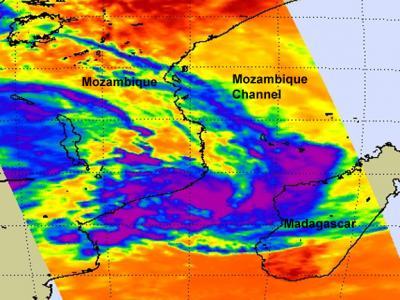Residents of Mozambique are still recovering from the flooding caused by Tropical Depression Dando earlier this week and now newly formed Tropical Cyclone Funso threatens to bring more rainfall to the country. NASA's Aqua satellite passed over Tropical Cyclone Funso on January 19 and provided forecasters with two different views of the intensifying storm.
At 0600 UTC on January 19, Tropical Storm Funso was located in the Mozambique Channel and about 685 miles (1,102 km) northeast of Maputo, the capital and largest city of Mozambique. Mauputo is located in the extreme southeast of Mozambique. Funso's center was near 17.3 South latitude and 40.7 East longitude. It was moving to the northwest near 5 knots (6 mph/9 kmh). Maximum sustained winds were near 35 knots (40 mph/65 kmh) making it a minimal tropical storm.
Five hours later, NASA's Aqua satellite passed over Tropical Storm Funso and captured visible and infrared data for forecasters.
The Moderate Resolution Imaging Spectroradiometer (MODIS) instrument aboard NASA's Aqua satellite captured a visible look at the clouds of Tropical Cyclone Funso (the eight depression in the Southern Indian Ocean this season) on January 19, 2012 at 11:03 UTC (6:03 a.m. EST).

NASA's Aqua satellite captured an infrared look at the temperatures of the clouds in Tropical Cyclone Funso on Jan. 19, 2012, at 10:59 UTC (5:59 a.m. EST). The coldest cloud top temperatures and strongest thunderstorms appear in purple, and were mostly over the open waters of the Mozambique Channel.
(Photo Credit: NASA JPL, Ed Olsen)
The MODIS image showed Funso was developing a signature "comma shape" in its clouds - a sign of a strengthening tropical storm. In the image, Funso's highest, strongest thunderstorms were visible around the center of circulation. Those high clouds (powerful, towering thunderstorms) were casting shadows on the lower surrounding clouds.
At the same time, another instrument on Aqua gave forecasters important information about the cloud temperatures of Cyclone Funso. The Atmospheric Infrared Sounder (AIRS) instrument saw that the coldest cloud top temperatures and strongest thunderstorms were mostly over the open waters of the Mozambique Channel at 11:00 UTC. Funso is stretched across the Mozambique Channel from east to west, and the western-most edge of Funso was bringing some moderate rainfall over central coastal Mozambique and the eastern-most extent was raining on western Madagascar.
The forecasters at the Joint Typhoon Warning Center expect Funso to move west then loop around and strengthen just off the central Mozambique coastline. Forecasters and residents of Mozambique are watching Funso's movements closely while still cleaning up from Tropical Depression Dando.
Source: NASA/Goddard Space Flight Center